2018 MERCEDES-BENZ CLA COUPE spare wheel
[x] Cancel search: spare wheelPage 290 of 326
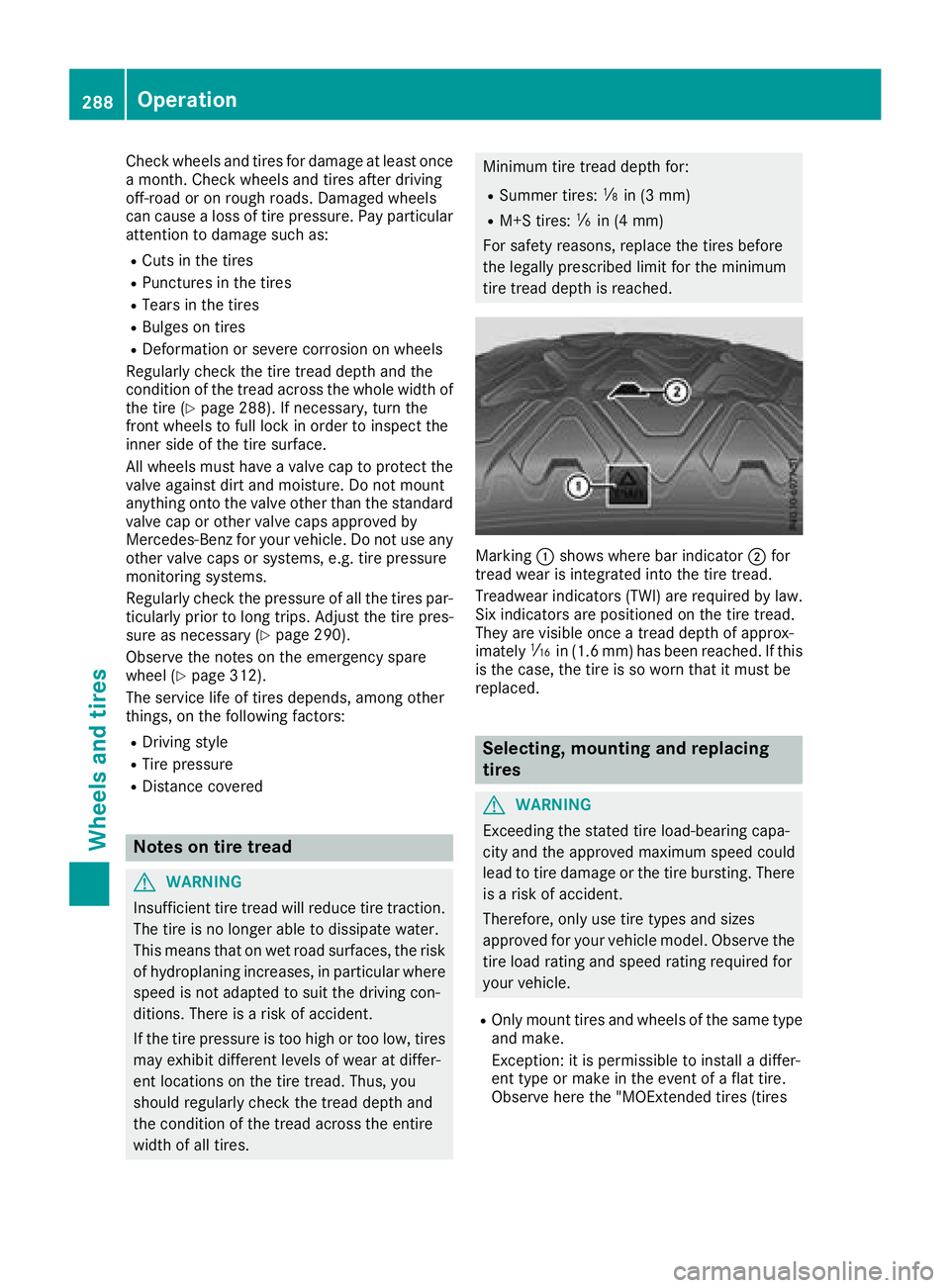
Checkwheelsand tires for damag eatleast once
am onth .Checkw heelsa nd tires after driving
off-road or on roug hroads. Damaged wheels
can caus ealoss of tir epressure. Pay particular
attentio ntodamagesucha s:
RCutsinthet ires
RPunctures inthet ires
RTearsint hetires
RBulges on tires
RDeformation or severe corrosiononw heels
Regularly check thetiret read dept hand the
conditio nofthetread across th ewhole widthof
th et ire(
Ypage 288). Ifnecessary, tur nthe
frontw heelstof ull lockino rder to inspectt he
inner sideof thetires urface.
All wheelsm ust haveavalvec ap to protect the
valv eagainst dirtand moisture. Do no tmount
anythingo ntot he valv eother than th estandard
valv ecap or other valv ecaps approved by
Mercedes-Ben zfor your veh icle.Don otuse any
other valv ecaps or systems ,e.g.t irep ressure
monitorin gsystems.
Regularly check thepressureofa llth et ires par-
ticularly priortol ongt rips. Adjus tthe tirep res-
sure as necessary (
Ypage 290).
Observ ethe note sont heemergenc yspare
wheel (
Ypage 312).
The servic elife of tires depends, amon gother
things, on th efollowin gfactors:
RDrivin gstyle
RTire pressure
RDistance covered
Notes on tir etread
GWAR NING
In suff icient tir etread will reduce tir etraction.
The tir eisnol ongerabletodissipat ewater.
This mean stha tonw et road surfaces ,the risk
of hydroplaning increases, inparticular where
speedisn otadapted to suit th edriving con-
dit ions. Thereisar iskofa cciden t.
If th et irep ressureist oohigh or to olow, tires
may exhibit diff erent levelsof wear at differ-
entl ocations on th etiret read. Thus,y ou
should regularly check th etread dept hand
th ec onditio noft hetread across th eentire
widt hofa lltires.
Minimum tir etread depthf or:
RSummer tires: âin(3 mm)
RM+S tires: ãin(4 mm)
For safety reasons, replace th etires before
th el egally prescribe dlimit for th eminimum
tir et read depthisr eached.
Marking:shows whereb ar indicator ;for
tread wear is integrate dintot he tiret read.
Treadwear indicators (TWI)a re requiredbylaw.
Six indicators are positione donthetiret read.
They are vis ibleonce atread depthofa pprox-
imately áin(1. 6m m) has been reached. Ifthis
is thec ase, th etireissow orn that it must be
replace d.
Selecting, mounting and replacing
tires
GWARNING
Exceedingt hestate dtirel oad-bearing capa-
cit ya nd th eapprove dmaximum speedc ould
lead to tir edamag eorthetireb ursting. There
is ar iskofa ccident.
Therefore, only use tiretype sand sizes
approve dfor your vehicle model. Observ ethe
tir el oad rating and speedr ating required for
your vehicle.
ROnly moun ttires and wheelsoft hesame type
and make.
Exception: itis permissible to install adiffer-
entt ype or mak eintheevent of aflat tire.
Observ eheret he"MOExtended tires (tires
288Operation
Wheels and tires
Page 291 of 326

with run-flat characteristics)"section
(Ypage 271).
ROnly mountt ires of thecorrects izeontot he
wheels.
RBreak in new tires at moderates peeds for the
first6 0miles (100km).The newt ires only
reacht heir full performanc eafter this dis-
tance.
RDo not drivew ith tires which have too little
tread depth, as this significantly reduces the
traction on wet roads (hydroplaning).
RReplace th etires after six years at th elatest,
regardless of wear.
Observe th enotes on th eemergency spare
wheel (
Ypage 312).
MOExtended tires (tires with run-flat
properties)
With MOExtended tires (tires with run flat char-
acteristics) ,you can continue to drivey our vehi-
cle even if there is atotal loss of pressure in one
or moret ires.
MOExtended tires may only be used in conjunc-
tio nw ith an activated tir epressure loss warning
system (Canada only) or tir epressure monitor
(USAo nly) and only on wheels specifically tes-
ted by Mercedes-Benz.
Notes on driving with MOExtended tires with a
flat tir e(
Ypage 271).
Vehicles equipped with MOExtended tires are
not equipped with aTIREFIT kit at th efactory. It
is therefore recommended that you additionally
equip your vehicle with aTIREFIT kit if you mount
tires that do not feature run-flat properties, e.g.
winter tires. ATIREFI Tkit may be obtained from
aq ualified specialist workshop.
Winter operation
General notes
Have your vehicle winter-proofed at aqualified
specialist workshop at th eonset of winter.
Observe th enotes in th e"Changing awheel"
sectio n(
Ypage 307).
Driving with summer tires
At temperatures below 45 ‡(+7 †) ,summe r
tire slos ee lasticit ya nd therefore traction and
braking power.C hange thetires on your vehicle
to M+S tires. Usings ummer tires at verycold
temperatures coul dcaus ecrack stof orm,
therebyd amaging th etires permanently.
Mercedes-Ben zcanno taccept responsibilityf or
this type of damage.
GWARNING
Damaged tires can caus etirei nflation pres-
sure loss.Asar esult, you couldlose control of
your vehicle .Thereisar isk of accident.
Checkt hetires regularly for signsofd amage
and replace any damage dtires immediately.
M+S tires
GWARNING
M+S tires with atiret read depthofl ess than
ã in(4 mm )are no tsuitable for use in winter
and do no tprovide sufficient traction.T hereis
ar isk of an accident.
M+S tires with atread depthofl ess thanãin
(4 mm) must be replaced immediately.
At temperatures below 45 ‡(+7 †), use winter
tires or all-season tires. Both type softire are
identified by the M+S marking.
Only winter tires bearing the isnowflake
symbol in addition to the M+S marking provide
the best possibleg rip in wintry road conditions.
Only these tires wil lallow driving safety systems
such as ABS and ESP
®to function optimally in
winter. Theset ires have beend eveloped specif-
ically for driving in snow.
Use M+S tires of the same make and tread on all
wheels to maintain safe handling characteris-
tics.
Always observe the maximu mpermissible
speeds pecified for the M+S tires you have
mounted.
Wintero peration289
Wheels and tires
Z
Page 292 of 326
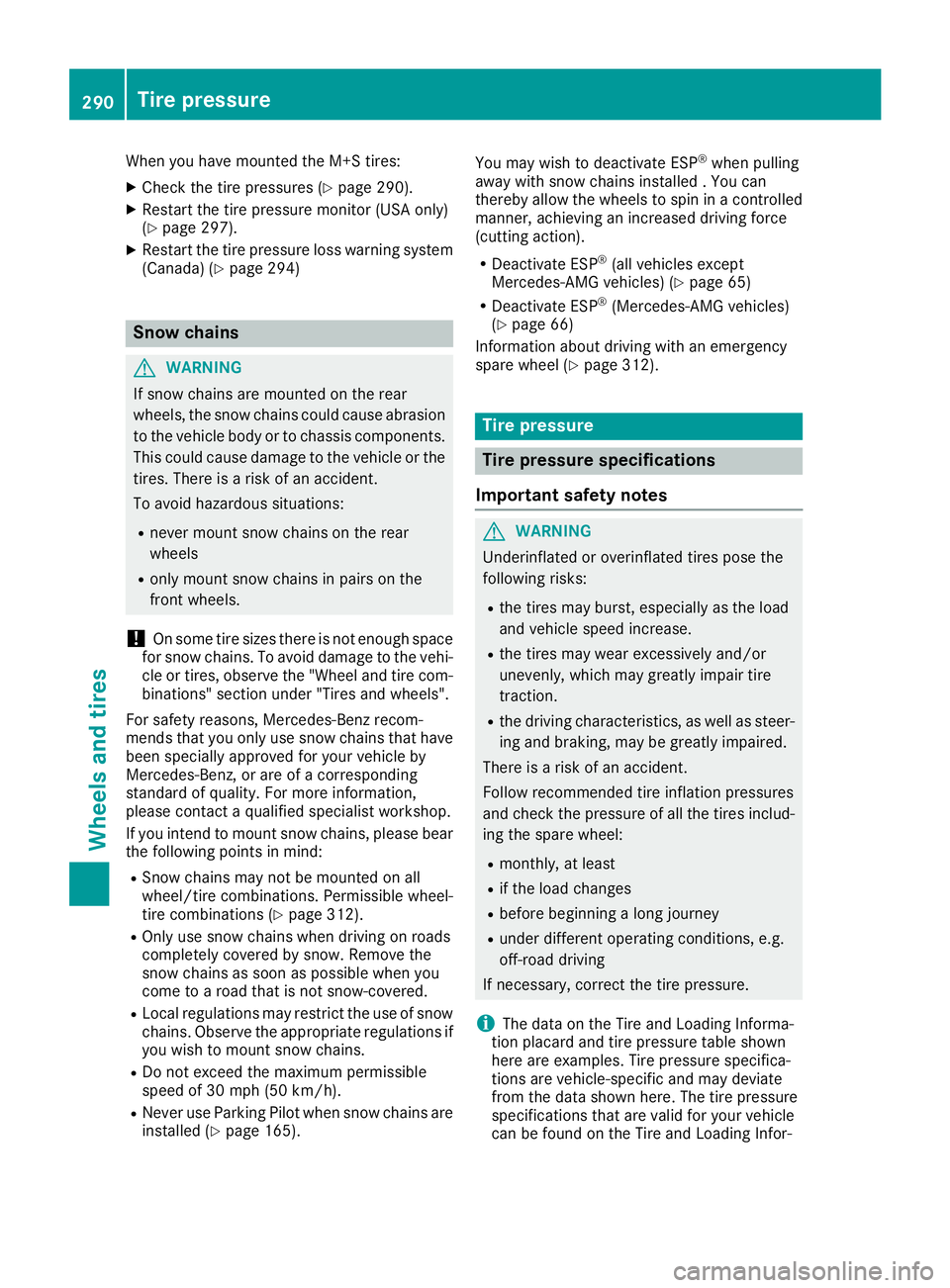
When you have mounted the M+S tires:
XCheck the tire pressures (Ypage 290).
XRestart the tire pressure monitor (USA only)
(Ypage 297).
XRestart the tire pressure loss warning system
(Canada) (Ypage 294)
Snow chains
GWARNING
If snow chains are mounted on the rear
wheels, the snow chains could cause abrasion
to the vehicle body or to chassis components.
This could cause damage to the vehicle or the
tires. There is arisk of an accident.
To avoid hazardous situations:
Rnever mount snow chains on the rear
wheels
Ronly mount snow chains in pairs on the
frontw heels.
!On some tire sizes there is not enough space
for snow chains. To avoid damage to the vehi-
cle or tires, observe the "Wheel and tire com-
binations" section under "Tires and wheels".
For safety reasons, Mercedes-Benz recom-
mends that you only use snow chains that have
been specially approved for your vehicle by
Mercedes-Benz ,orare of acorresponding
standard of quality. For more information,
please contact aqualified specialist workshop.
If you inten dtomount snow chains, please bear
the following points in mind:
RSno wchains may not be mounted on all
wheel/tire combinations. Permissible wheel-
tire combinations (
Ypage 312).
ROnly use snow chains when driving on roads
completely covered by snow. Remove the
snow chains as soon as possible when you
come to aroad that is not snow-covered.
RLocal regulations may restrict the use of snow
chains. Observe the appropriate regulations if
you wish to mount snow chains.
RDo not exceed the maximum permissible
speed of 30 mph (50 km/h).
RNever use Parking Pilot when snow chains are
installed (Ypage 165). You may wish to deactivat
eESP
®when pulling
away with snow chains installed .You can
thereby allow the wheels to spin in acontrolled
manner, achieving an increased driving force
(cutting action).
RDeactivate ESP®(all vehicles except
Mercedes-AMG vehicles) (Ypage 65)
RDeactivate ESP®(Mercedes-AMG vehicles)
(Ypage 66)
Information about driving with an emergency
spare wheel (
Ypage 312).
Tirep ressure
Tirep ressure specifications
Important safety notes
GWARNING
Underinflated or overinflated tires pose the
following risks:
Rthe tires may burst, especially as the load
and vehicle speed increase.
Rthe tires may wear excessively and/or
unevenly, which may greatly impair tire
traction.
Rthe driving characteristics, as well as steer-
ing and braking, may be greatly impaired.
There is arisk of an accident.
Follow recommended tire inflation pressures
and check the pressure of all the tires includ-
ing the spare wheel:
Rmonthly, at least
Rif the load changes
Rbefore beginnin galong journey
Runder differento perating conditions, e.g.
off-road driving
If necessary, correct the tire pressure.
iThe data on the Tire and Loading Informa-
tion placard and tire pressure table shown
here are examples. Tire pressure specifica-
tions are vehicle-specific and may deviate
from the data shown here. The tire pressure
specifications that are valid for your vehicle
can be found on the Tire and Loading Infor-
290Tirep ressure
Wheels and tires
Page 293 of 326
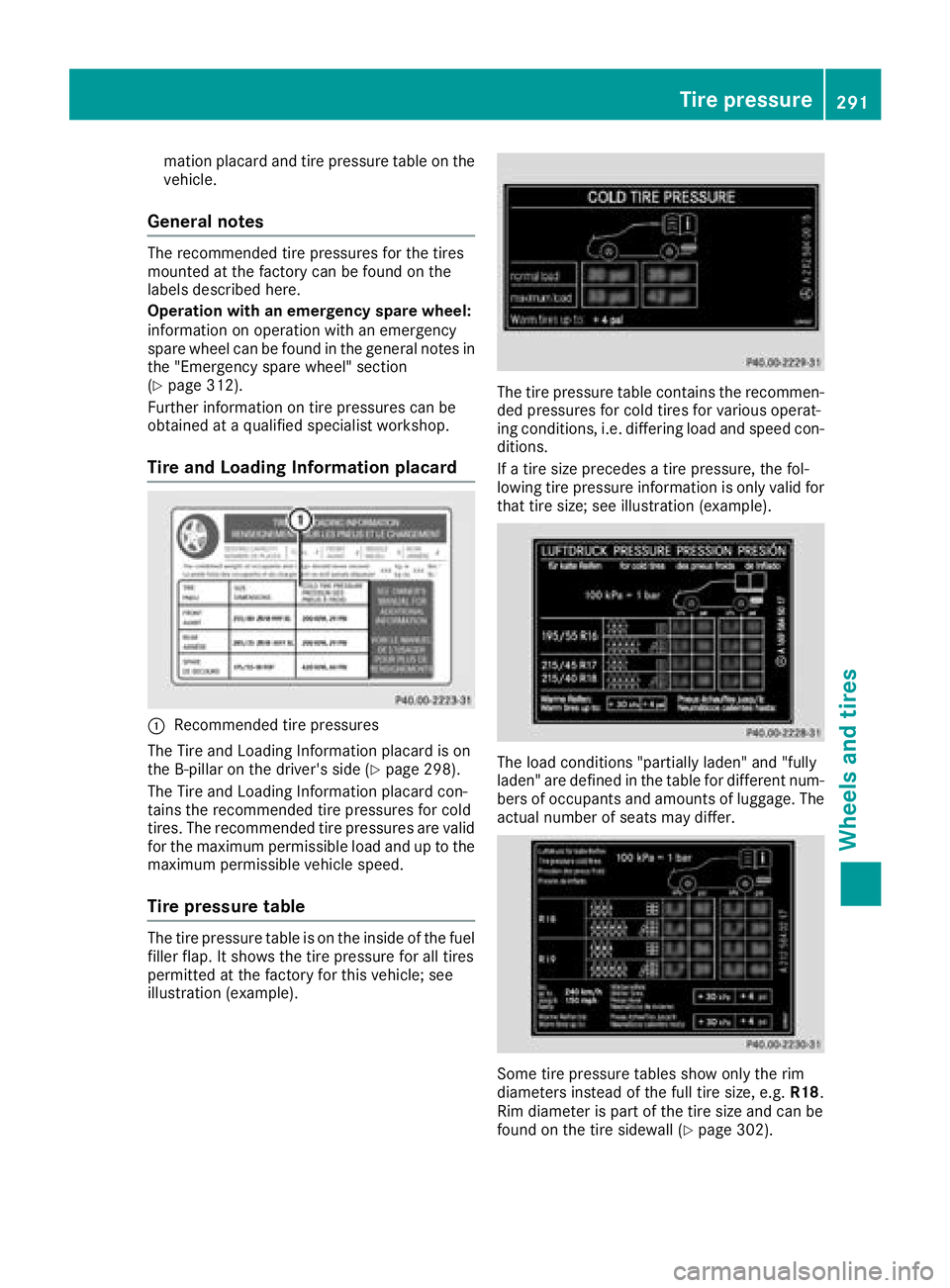
mation placard and tire pressure table on the
vehicle.
General notes
The recommended tire pressures for the tires
mounted at the factory can be found on the
labels described here.
Operation with an emergency spare wheel:
informationonoperation with an emergency
spare wheelc an be found in the general notes in
the "Emergency spare wheel" section
(
Ypage 312).
Further informatio nontire pressures can be
obtained at aqualified specialist workshop.
Tire and Loading Information placard
:Recommended tire pressures
The Tire and Loading Information placard is on
the B-pillar on the driver'ss ide (
Ypage 298).
The Tire and Loading Information placard con-
tains the recommended tire pressures for cold
tires. The recommended tire pressures are valid
for the maximu mpermissiblel oadand up to the
maximu mpermissiblev ehiclespeed.
Tire pressure table
The tire pressure table is on the inside of the fuel
filler flap .Itshows the tire pressure for all tires
permitted at the factory for this vehicle; see
illustratio n(example).
The tire pressure table contains the recommen-
ded pressures for cold tires for various operat-
ing conditions, i.e. differing loada nd speed con-
ditions.
If at ire size precedesat ire pressure, the fol-
lowing tire pressure informatio nisonly vali dfor
that tire size; see illustratio n(example).
The loadc onditions "partiall yladen" and "fully
laden" are defined in the table for different num-
bers of occupants and amounts of luggage .The
actua lnumber of seats may differ.
Some tire pressure table sshow only the rim
diameters instead of the full tire size, e.g. R18.
Rim diameter is part of the tire size and can be
found on the tire sidewal l(
Ypage 302).
Tire pressure291
Wheelsand tires
Z
Page 294 of 326
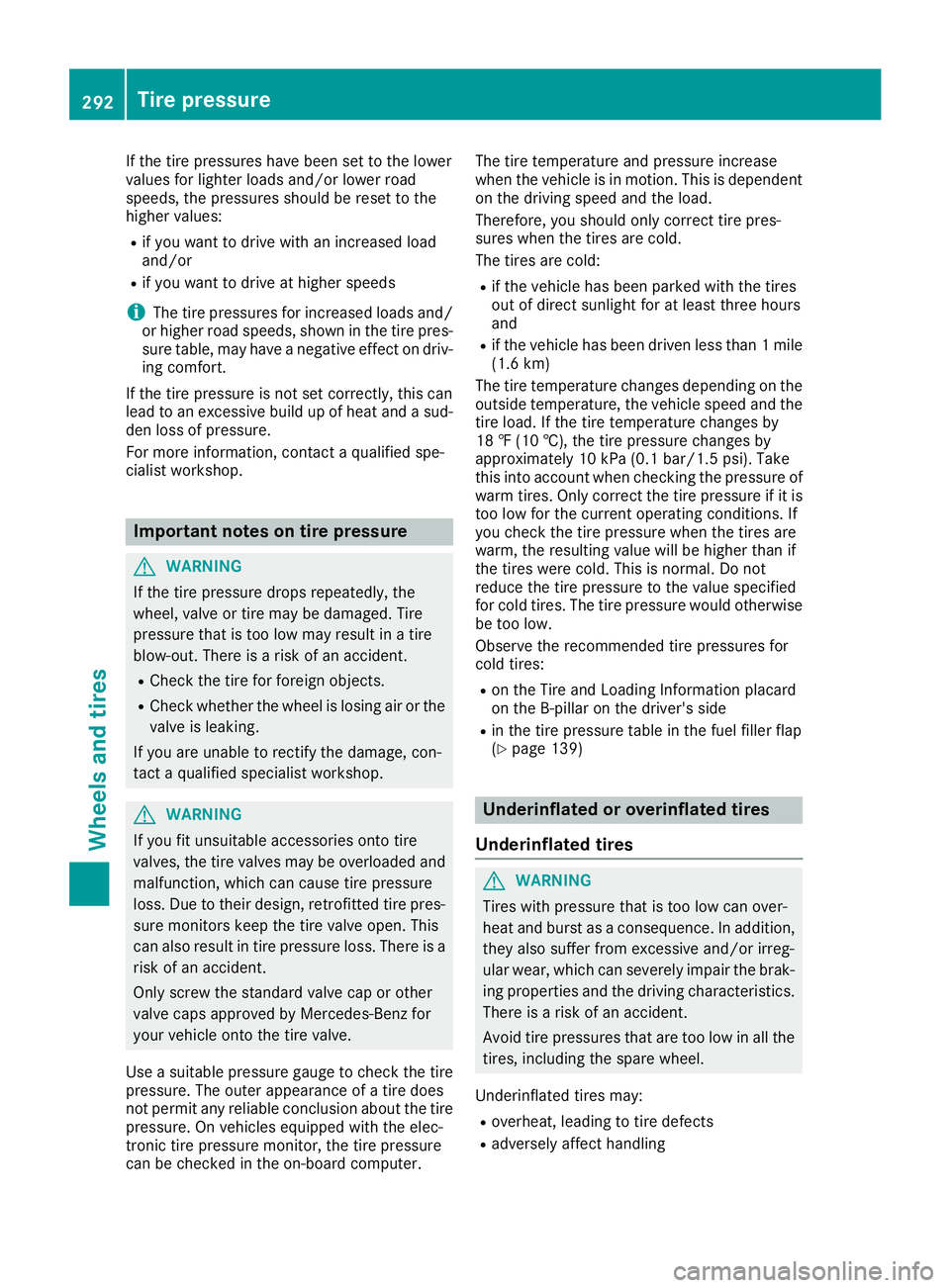
If the tire pressures have been set to the lower
values for lighter loadsand/or lowerroad
speeds, the pressures shoul dbereset to the
higher values:
Rif you want to drive with an increased load
and/or
Rif you want to drive at higher speeds
iThe tire pressures for increased loadsa nd/
or higher road speeds, shown in the tire pres-
sure table, may have anegative effect on driv-
ing comfort.
If the tire pressure is not set correctly, this can
leadtoane xcessive build up of heat and asud-
den loss of pressure.
For more information, contact aqualifieds pe-
cialist workshop.
Important notes on tire pressure
GWARNING
If the tire pressure drops repeatedly,t he
wheel,v alve or tire may be damaged. Tire
pressure that is too low may resultinatire
blow-out. There is arisk of an accident.
RCheck the tire for foreign objects.
RCheck whether the wheel is losing air or the
valve is leaking.
If you are unabl etorectify the damage, con-
tact aqualifieds pecialist workshop.
GWARNING
If you fit unsuitable accessorieso nto tire
valves ,the tire valves may be overloaded and
malfunction, which can cause tire pressure
loss. Due to their design, retrofitted tire pres- sure monitors keep the tire valve open. This
can also resultint ire pressure loss. There is a
risk of an accident.
Only screw the standard valve cap or other
valve caps approved by Mercedes-Benz for
you rvehicle onto the tire valve.
Use asuitable pressure gauge to check the tire
pressure. The outer appearance of atire does
not permit any reliable conclusion aboutt he tire
pressure. On vehiclese quipped with the elec-
tronic tire pressure monitor, the tire pressure
can be checked in the on-board computer. The tire temperature and pressure increase
when the vehicle is in motion. This is dependent
on the driving speed and the load.
Therefore, you shoul
donly correct tire pres-
sures when the tires are cold.
The tires are cold:
Rif the vehicle has been parked with the tires
out of direct sunlight for at least three hours
and
Rif the vehicle has been driven less than 1mile
(1.6 km)
The tire temperature changes depending on the
outsidet emperature ,the vehicle speed and the
tire load.Ift he tire temperature changes by
18 ‡(10 †), the tire pressure changes by
approximately 10 kPa (0.1 bar/1.5 psi).T ake
this into account when checking the pressure of
warm tires. Only correct the tire pressure if it is
too low for the current operating conditions. If
you check the tire pressure when the tires are
warm, the resulting valuew illbehigherthan if
the tires were cold. This is normal. Do not
reduce the tire pressure to the values pecified
for cold tires. The tire pressure would otherwise
be too low.
Observe the recommended tire pressures for
cold tires:
Ron the Tire and Loading Information placard
on the B-pillaront he driver's side
Rin the tire pressure table in the fuel fillerf lap
(Ypage 139)
Underinflated or overinflated tires
Underinflated tires
GWARNING
Tires with pressure that is too low can over-
heat and burst as aconsequence. In addition,
they also suffer from excessive and/or irreg-
ularw ear, which can severelyi mpair the brak-
ing propertiesa nd the driving characteristics.
There is arisk of an accident.
Avoid tire pressures that are too low in all the
tires, including the spare wheel.
Underinflated tires may:
Roverheat, leading to tire defects
Radversely affect handling
292Tire pressure
Wheelsa nd tires
Page 295 of 326
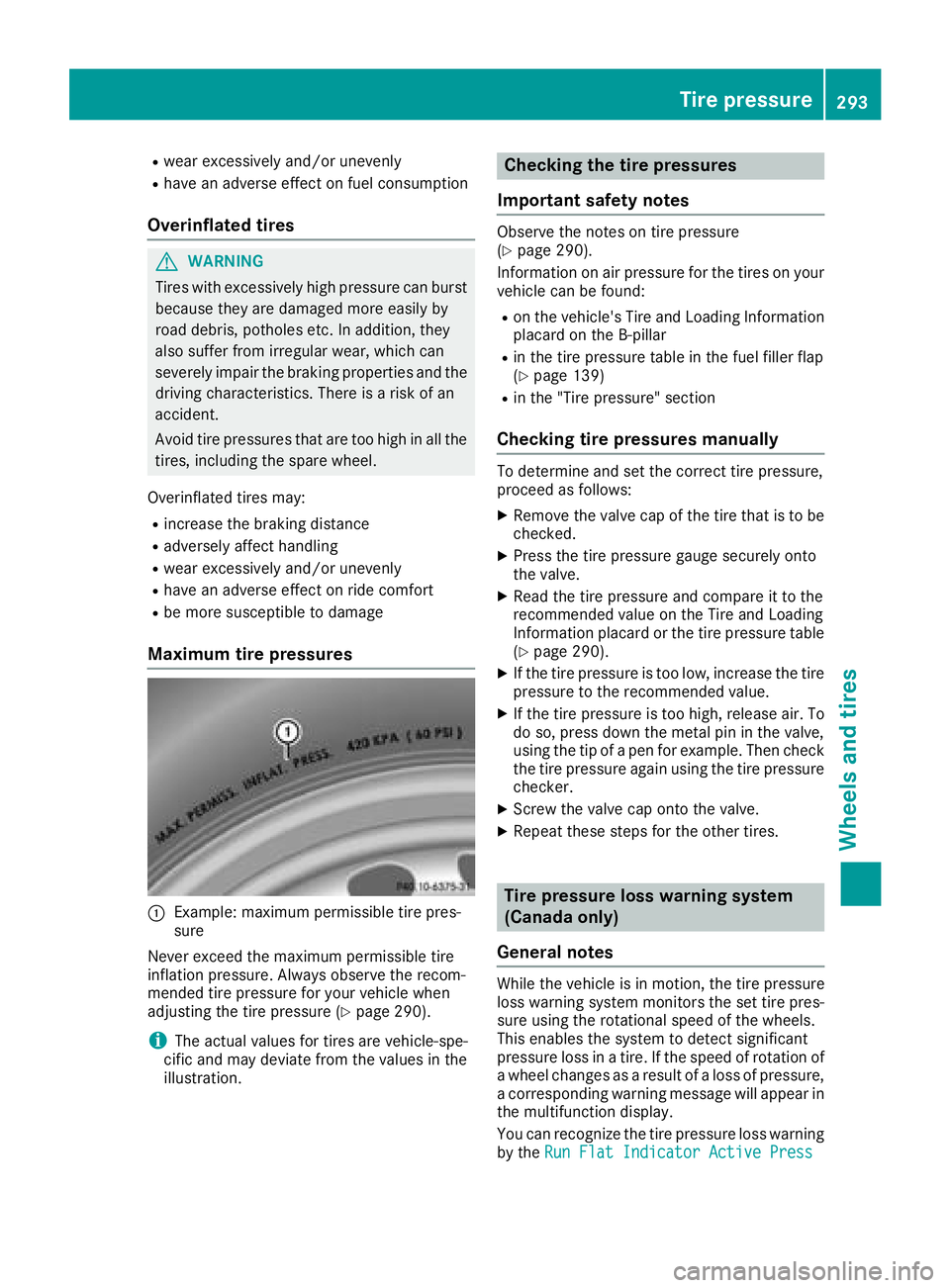
Rwear excessively and/or unevenly
Rhave an adverse effect on fuel consumption
Overinflated tires
GWARNING
Tires with excessively high pressure can burst
becaus etheya re damaged moree asily by
road debris,p otholes etc.Inaddition, they
also suffer fromi rregular wear, which can
severely impair th ebraking properties and the
driving characteristics. Thereisar isk of an
accident.
Avoid tir epressures that are too high in all the
tires, including th espare wheel.
Overinflated tires may:
Rincrease th ebraking distance
Radversely affect handling
Rwear excessively and/or unevenly
Rhave an adverse effect on ride comfort
Rbe mores usceptible to damage
Maximumtirep ressures
:Example: maximum permissible tir epres-
sure
Never exceed th emaximum permissible tire
inflatio npressure. Always observe th erecom-
mended tir epressure for your vehicle when
adjustin gthe tirep ressure (
Ypage 290).
iThe actual values for tires are vehicle-spe-
cific and may deviat efromt hevalues in the
illustration.
Checking th etirep ressures
Important safety notes
Observe th enotes on tir epressure
(Ypage 290).
Information on air pressure for th etires on your
vehicle can be found:
Ron th evehicle's Tire and LoadingI nformation
placar dontheB-pillar
Rin th etirep ressure table in th efuel filler flap
(Ypage 139)
Rin th e"Tire pressure" section
Checking tir epressures manually
To determine and set th ecorrectt irep ressure,
proceed as follows:
XRemovet hevalve cap of th etiret hatistob e
checked.
XPresst hetirep ressure gauge securely onto
th ev alve.
XRead th etirep ressure and compare it to the
recommended value on th eTire and Loading
Information placar dorthetirep ressure table
(
Ypage 290).
XIf th etirep ressure is too low, increase th etire
pressure to th erecommended value.
XIf th etirep ressure is too high, releasea ir. To
do so, pressd own themetal pin in th evalve,
using th etip of apen for example. Then check
th et irep ressure again using th etirep ressure
checker.
XScrew th evalve cap ont othe valve.
XRepeat these steps for th eother tires.
Tirep ressurel oss warning system
(Canada only)
General notes
While th evehicle is in motion, th etirep ressure
loss warning system monitors th eset tir epres-
sure using th erotational speed of th ewheels.
This enables th esystem to detect significant
pressure loss in atire. If th espeed of rotation of
aw heel changes as aresult of aloss of pressure,
ac orresponding warning message will appear in
th em ultifunction display.
You can recognize th etirep ressure loss warning
by the Run Flat IndicatorA ctive Press
Tirep ressure293
Wheels and tires
Z
Page 297 of 326

shown in theServ.menu of the multifunction
display, see illustration (example).
For information on the message display, refer to
the "Checking the tire pressure electronically"
section (
Ypage 296).
Important safety notes
GWARNING
Each tire, including the spare (if provided),
should be checked at least once every two
weeks when cold and inflated to the pressure recommended by the vehicle manufacturer
on the Tire and Loading Information placard
on the driver's door B-pillar or the tire pres-
sure label on the inside of the fuel filler flap. If
your vehicle has tires of adifferent size than
the size indicated on the Tire and Loading
Information placard or, if available, the tire
pressure label,y ou should determine the
proper tire pressure for those tires.
As an added safety feature, your vehicle has
been equipped with atire pressure monitoring
system (TPMS) that illuminates alow tire pres-
sure telltale when one or more of your tires
are significantly underinflated. Accordingly,
when the low tire pressure telltale lights up,
you should stop and check your tires as soon
as possible,a nd inflate them to the proper
pressure. Driving on asignificantly underin-
flated tire causes the tire to overheat and can
lead to tire failure.
Underinflation also reduces fuel efficiency
and tire tread life, and may affect the vehicle's
handling and stopping ability. Please note that the TPMS is not asubstitute for proper tire
maintenance, and it is the driver's responsi-
bility to maintain correct tire pressure, even if
underinflation has not reached the level to
trigger illumination of the TPMS low tire pres- sure telltale.
Your vehicle has also been equipped with a
TPMS malfunction indicator to indicate when
the system is not operating properly. The
TPMS malfunction indicator is combined with
the low tire pressure telltale. When the sys-
tem detects amalfunction, the warning lamp
will flash for approximately aminute and then
remain continuously illuminated. This
sequence will be repeated every time the vehi-
cle is started as long as the malfunction
exists. When the malfunction indicator is illu-
minated, the system may not be able to detect
or signal low tire pressure as intended.
TPMS malfunctions may occur for avariety of
reasons, including the installation of incom-
patible replacement or alternate tires or
wheels on the vehicle that prevent the TPMS
from functioningp roperly. Always check the
TPMS malfunction telltale after replacing one
or more tires or wheels on your vehicle to
ensure that the replacement or alternate Tires
and wheels allow the TPMS to continue to
function properly.
It is the driver's responsibility to set the tire
pressure to that recommended for cold tires
which is suitable for the operating situation
(
Ypage 290). Note that the correct tire pressure
for the current operating situation must first be
taught-in to the tire pressure monitor. If asub-
stantial loss of pressure occurs, the warning
threshold for the warning message is aligned to
the taught-in reference values. Restart the tire
pressure monitor after adjusting the pressure of
the cold tires (
Ypage 297). The current pres-
sures are saved as new reference values. As a
result, awarning message will appearift he tire
pressure drops significantly.
The tire pressure monitor does not warn you of
an incorrectly set tire pressure. Observe the
notes on the recommended tire pressure
(
Ypage 290).
The tire pressure monitor is not able to warn you
of as udden loss of pressure, e.g. if the tire is
penetrated by aforeign object. In the event of a
sudden loss of pressure, bring the vehicle to a
halt by braking carefully.A void abrupt steering
movements.
Tire pressure295
Wheels and tires
Z
Page 298 of 326
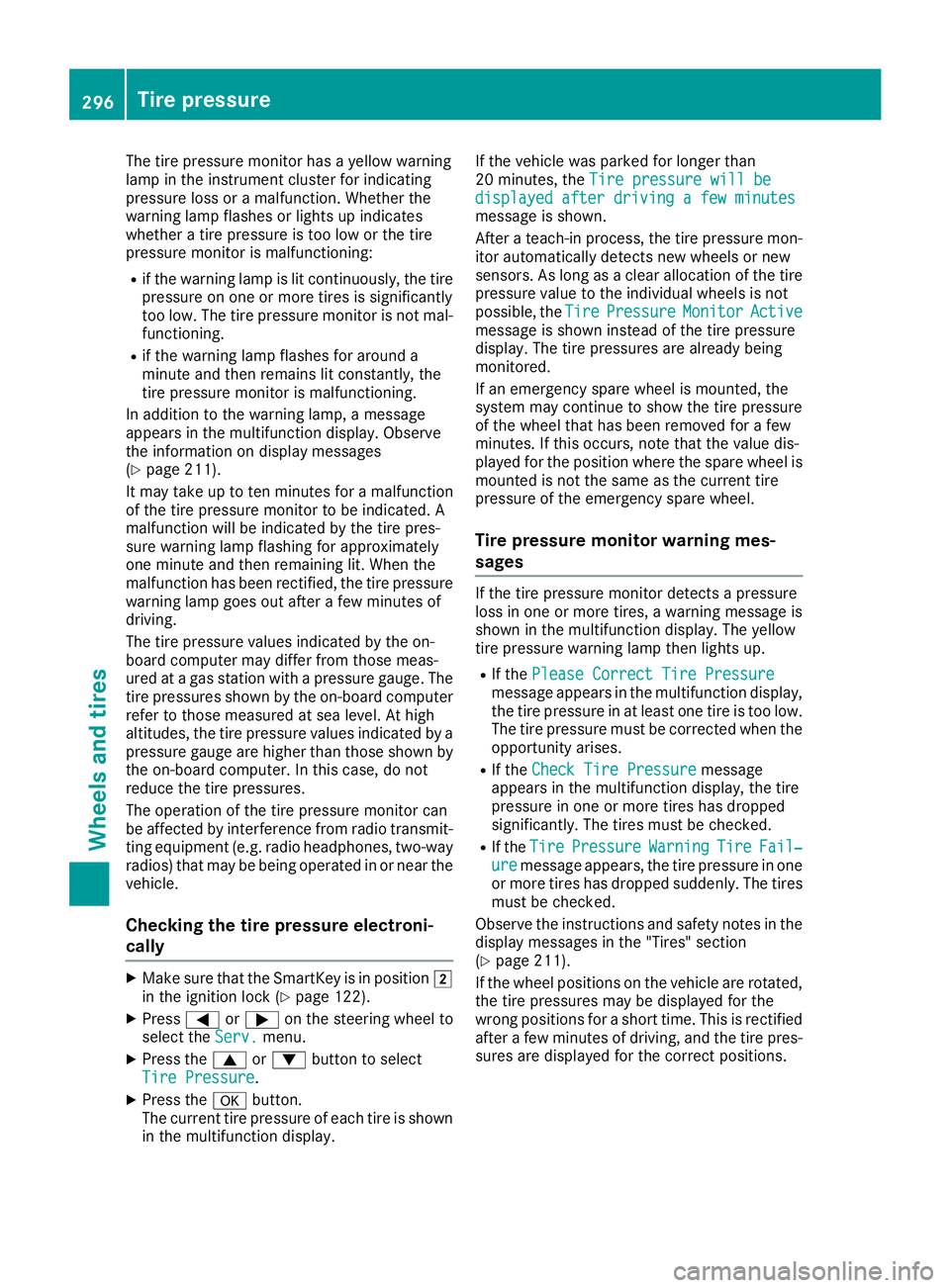
The tire pressure monitor hasayellow warning
lamp in the instrument cluster for indicating
pressure loss or amalfunction. Whether the
warning lamp flashes or lights up indicates
whether atire pressure is too low or the tire
pressure monitor is malfunctioning:
Rif the warning lamp is lit continuously, the tire
pressure on one or more tires is significantly
too low. The tire pressure monitor is not mal- functioning.
Rif the warning lamp flashes for around a
minute and then remains lit constantly, the
tire pressure monitor is malfunctioning.
In addition to the warning lamp, amessage
appears in the multifunction display.O bserve
the information on display messages
(
Ypage 211).
It may take up to ten minutes for amalfunction
of the tire pressure monitor to be indicated. A
malfunction will be indicated by the tire pres-
sure warning lamp flashing for approximately
one minute and then remaining lit. When the
malfunction has been rectified, the tire pressure
warning lamp goes out after afew minutes of
driving.
The tire pressure values indicated by the on-
board computer may differ from those meas-
ured at agas station with apressure gauge. The
tire pressures shown by the on-board computer
refer to those measured at sea level. At high
altitudes, the tire pressure values indicated by a
pressure gauge are higher than those shown by the on-board computer. In this case, do not
reduce the tire pressures.
The operation of the tire pressure monitor can
be affected by interferenc efrom radio transmit-
ting equipment (e.g. radio headphones, two-way
radios) that may be being operated in or near the vehicle.
Checking the tire pressur eelectroni-
cally
XMake sure that the SmartKey is in position 2
in the ignition lock (Ypage 122).
XPress =or; on the steerin gwheel to
select the Serv.menu.
XPress the9or: button to select
Tire Pressure.
XPress the abutton.
The current tire pressure of each tire is shown
in the multifunction display. If the vehicle was parked for longer than
20 minutes, the
Tire pressure will be
displayed after driving afew minutesmessage is shown.
After ateach-in process, the tire pressure mon-
itor automatically detect snew wheels or new
sensors. As long as aclear allocation of the tire
pressure value to the individual wheels is not
possible, the Tire
PressureMonitorActivemessage is shown instead of the tire pressure
display.The tire pressures are already being
monitored.
If an emergencys pare wheel is mounted, the
system may continue to show the tire pressure
of the wheel that has been removed for afew
minutes. If this occurs, notet hat the value dis-
played for the position where the spare wheel is
mounted is not the same as the current tire
pressure of the emergencys pare wheel.
Tire pressuremonitor warning mes-
sages
If the tire pressure monitor detect sapressure
loss in one or more tires, awarning message is
shown in the multifunction display.T he yellow
tire pressure warning lamp then lights up.
RIf the Please Correct Tire Pressuremessage appears in the multifunction display,
the tire pressure in at least one tire is too low.
The tire pressure must be corrected when the
opportunit yarises.
RIf the Check Tire Pressuremessage
appears in the multifunction display,t he tire
pressure in one or more tires has dropped
significantly. The tires must be checked.
RIf the TirePressureWarningTireFail‐uremessage appears, the tire pressure in one
or more tires has dropped suddenly. The tires
must be checked.
Observe the instructions and safety notes in the
display messages in the "Tires" section
(
Ypage 211).
If the wheel positions on the vehicle are rotated,
the tire pressures may be displayed for the
wrong positions for ashort time. This is rectified
after afew minutes of driving, and the tire pres-
sures are displayed for the correctp ositions.
296Tirepressure
Wheels and tires